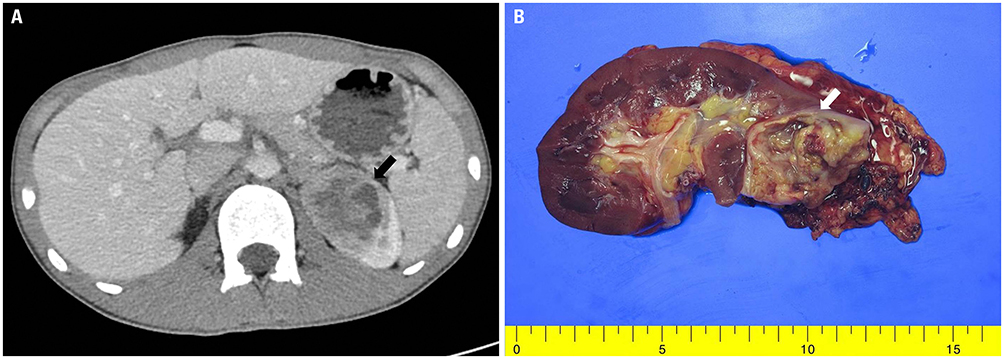Yonsei Med J.
2020 Mar;61(3):262-266. 10.3349/ymj.2020.61.3.262.
Characteristics of Renal Cell Carcinoma Harboring TPM3-ALK Fusion
- Affiliations
-
- 1Department of Pathology, Chungbuk National University Hospital, Cheongju, Korea. md5218@naver.com
- 2Department of Pathology, Chungbuk National University College of Medicine, Cheongju, Korea.
- 3Department of Urology, Chungbuk National University Hospital, Cheongju, Korea.
- 4Department of Urology, Chungbuk National University College of Medicine, Cheongju, Korea.
- KMID: 2470924
- DOI: http://doi.org/10.3349/ymj.2020.61.3.262
Abstract
- The World Health Organization 2016 edition assigned anaplastic lymphoma kinase (ALK) rearrangement-associated renal cell carcinoma (ALK-RCC) as an emerging renal tumor entity. Identifying ALK-RCC is important because ALK inhibitors have been shown to be effective in treatment. Here, we report the case of a 14-year-old young man with ALK-RCC. Computed tomography revealed a well-demarcated 5.3-cm enhancing mass at the upper pole of the left kidney. There was no further history or symptoms of the sickle-cell trait. The patient underwent left radical nephrectomy. Pathologically, the mass was diagnosed as an unclassified RCC. Targeted next-generation sequencing identified a TPM3-ALK fusion gene. The present report and literature review demonstrate that TPM3-ALK RCC may be associated with distinct clinicopathological features. Microscopically, the tumors showed diffuse growth and tubulocystic changes with inflammatory cell infiltration. Tumor cells were dis-cohesive and epithelioid with abundant eosinophilic cytoplasm and cytoplasmic vacuoles. If morphological features and TFE3 expression are present in adolescent and young patients, molecular tests for ALK translocation should be performed. This awareness is critically important, because ALK rearrangement confers sensitivity to ALK inhibitors.
Keyword
MeSH Terms
Figure
Reference
-
1. Pulford K, Lamant L, Morris SW, Butler LH, Wood KM, Stroud D, et al. Detection of anaplastic lymphoma kinase (ALK) and nucleolar protein nucleophosmin (NPM)-ALK proteins in normal and neoplastic cells with the monoclonal antibody ALK1. Blood. 1997; 89:1394–1404.
Article2. Hallberg B, Palmer RH. Mechanistic insight into ALK receptor tyrosine kinase in human cancer biology. Nat Rev Cancer. 2013; 13:685–700.
Article3. Trpkov K, Hes O. New and emerging renal entities: a perspective post-WHO 2016 classification. Histopathology. 2019; 74:31–59.
Article4. Sukov WR, Hodge JC, Lohse CM, Akre MK, Leibovich BC, Thompson RH, et al. ALK alterations in adult renal cell carcinoma: frequency, clinicopathologic features and outcome in a large series of consecutively treated patients. Mod Pathol. 2012; 25:1516–1525.
Article5. Cajaiba MM, Dyer LM, Geller JI, Jennings LJ, George D, Kirschmann D, et al. The classification of pediatric and young adult renal cell carcinomas registered on the children's oncology group (COG) protocol AREN03B2 after focused genetic testing. Cancer. 2018; 124:3381–3389.
Article6. Sugawara E, Togashi Y, Kuroda N, Sakata S, Hatano S, Asaka R, et al. Identification of anaplastic lymphoma kinase fusions in renal cancer: large-scale immunohistochemical screening by the intercalated antibody-enhanced polymer method. Cancer. 2012; 118:4427–4436.
Article7. Lee C, Park JW, Suh JH, Nam KH, Moon KC. ALK-positive renal cell carcinoma in a large series of consecutively resected Korean renal cell carcinoma patients. Korean J Pathol. 2013; 47:452–457.
Article8. Pal SK, Bergerot P, Dizman N, Bergerot C, Adashek J, Madison R, et al. Responses to alectinib in ALK-rearranged papillary renal cell carcinoma. Eur Urol. 2018; 74:124–128.
Article9. Tao JJ, Wei G, Patel R, Fagan P, Hao X, Bridge JA, et al. ALK fusions in renal cell carcinoma: response to entrectinib. JCO Precis Oncol. 2018; 11. 27. DOI: 10.1200/PO.18.00185. [Epub].
Article10. Bodokh Y, Ambrosetti D, Kubiniek V, Tibi B, Durand M, Amiel J, et al. ALK-TPM3 rearrangement in adult renal cell carcinoma: report of a new case showing loss of chromosome 3 and literature review. Cancer Genet. 2018; 221:31–37.
Article11. Thorner PS, Shago M, Marrano P, Shaikh F, Somers GR. TFE3-positive renal cell carcinomas are not always Xp11 translocation carcinomas: report of a case with a TPM3-ALK translocation. Pathol Res Pract. 2016; 212:937–942.
Article12. Smith NE, Deyrup AT, Mariño-Enriquez A, Fletcher JA, Bridge JA, Illei PB, et al. VCL-ALK renal cell carcinoma in children with sickle-cell trait: the eighth sickle-cell nephropathy? Am J Surg Pathol. 2014; 38:858–863.13. Yu W, Wang Y, Jiang Y, Zhang W, Li Y. Genetic analysis and clinicopathological features of ALK-rearranged renal cell carcinoma in a large series of resected Chinese renal cell carcinoma patients and literature review. Histopathology. 2017; 71:53–62.
Article14. Armstrong F, Lamant L, Hieblot C, Delsol G, Touriol C. TPM3-ALK expression induces changes in cytoskeleton organisation and confers higher metastatic capacities than other ALK fusion proteins. Eur J Cancer. 2007; 43:640–646.
Article15. Shin S, Kim J, Yoon SO, Kim YR, Lee KA. ALK-positive anaplastic large cell lymphoma with TPM3-ALK translocation. Leuk Res. 2012; 36:e143–e145.
Article
- Full Text Links
- Actions
-
Cited
- CITED
-
- Close
- Share
- Similar articles
-
- ALK-Positive Renal Cell Carcinoma in a Large Series of Consecutively Resected Korean Renal Cell Carcinoma Patients
- Bilateral Ovarian Metastases from ALK Rearranged Non-Small Cell Lung Cancer
- EML4-ALK Fusion Gene in Korean Non-Small Cell Lung Cancer
- Analysis of Histologic Features Suspecting Anaplastic Lymphoma Kinase (ALK)-Expressing Pulmonary Adenocarcinoma
- A Case of Renal Cell Carcinoma in Childhood



